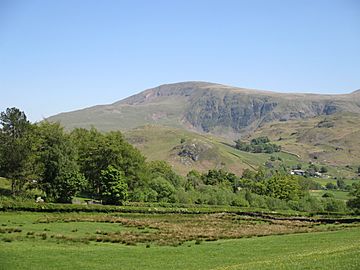Low Rigg facts for kids
Quick facts for kids Low Rigg |
|
|---|---|

A view of Low Rigg from the west, with Skelthwaite Crag in front of it.
|
|
| Highest point | |
| Elevation | c.277 m |
| Prominence | c.55 m |
| Parent peak | High Rigg |
| Geography | |
| Location | Lake District, England |
Low Rigg is a small, interesting hill located in the beautiful Lake District in England. It's found a few miles east of the town of Keswick. This hill is a bit smaller than its neighbor, High Rigg, which is just to its north.
Even though Low Rigg isn't one of the tallest mountains, it offers amazing views. From its top, you can see famous mountains like Blencathra and Clough Head.
What is Low Rigg?
Low Rigg is considered a "modest" hill because it's not tall enough to be included in some of the most famous guides to the Lake District, like those written by Alfred Wainwright. However, its lower height makes it a great place for a shorter walk. It's also perfect for enjoying wide-open views of the bigger mountains around it without a long, tough climb.
How Was Low Rigg Formed?
Low Rigg has a unique geological story. It was formed from a type of rock called granite. Imagine a bubble of hot, melted rock, called magma, pushing up from deep inside the Earth. This magma pushed into the layers of rock above it but didn't break through to the surface. Instead, it spread out like a lens or a mushroom shape. This kind of rock formation is called a laccolith. Over a very long time, the softer rocks above it wore away, leaving Low Rigg exposed.
Exploring Low Rigg
Low Rigg is a great spot for a short walk. You can easily climb the hill from the Naddle Valley or from a place called St John's in the Vale. The paths are not too difficult, making it a good choice for families or anyone looking for a nice, easy hike.
One special feature of Low Rigg is Tewet Tarn. A tarn is a small mountain lake or pond, often formed in a hollow created by glaciers. Tewet Tarn is a lovely body of water that adds to the beauty of the area. It's something you won't find on its larger neighbor, High Rigg.

